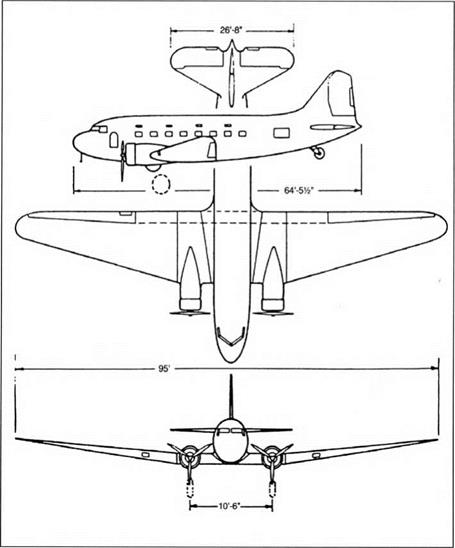ERA OF THE MATURE PROPELLER-DRIVEN AIRPLANE
Perhaps one of the best examples of an aircraft during the era of the mature propeller-driven airplane is the Douglas DC-3 (Figure 4) from the 1930s. The aerodynamic hallmark of this generation of airplanes is streamlining. Let us briefly examine some historical aspects of streamlining.
A clarion call for the advantages of streamlining was made by Sir Melvill Jones in 1929. Jones, a respected professor of aeronautical engineering at Cambridge University, gave a lecture to the Royal Aeronautical Society in 1929 entitled “The Streamline Airplane.”10 Jones’ engineering analysis of the drag reduction that could
be achieved by the streamlining was so compelling that, in the words of Miller and Sawers, “designers were shocked into greater awareness of the value of streamlining.”11 Jones’ paper was a turning point in the practice of aerodynamics during the age of the mature propeller-driven airplane. This work was pure aeronautical engineering carried out by a respected academic.
Two other milestones involved drag reduction during this era; they were the development of the NACA cowling, and the detailed drag clean-up work – both carried out by engineers at the NACA Langley Memorial Laboratory. The cowling, a streamlined metal shroud wrapped around the cylinders of a radial piston engine,
|
|
was developed by Fred Weick and colleagues through extensive parametric testing in the Propeller Research Tunnel at Langley in 1928. The results were dramatic – the drag for a fuselage with the engine wrapped in the NACA cowling was 60 percent less than that for the fuselage with the engine cylinders exposed to the air. The normally staid NACA knew they had something very important, and no time was lost in getting the data to industry. The Lockheed Vega was the first production airplane to incorporate the NACA cowling in 1929. The top speed of the Vega was increased from 165 mph for the uncowled version to 190 mph for the cowled version – spectacular success. The cowling was developed at that time without any understanding of the basic aerodynamic reasons for its success; the work was all based on parametric testing in the wind tunnel. The fundamental understanding of the flow associated with the cowling, as well as the derivation of a theoretical approach to calculating cowling performance, was finally achieved by Theodore Theodorsen in 1937. Theodorsen was the NACA’s leading theoretician at that time. Analytical understanding was finally achieved, but the NACA cowling had been in use for eight years prior to that. The development of the cowling, and its empirical application to airplanes was pure engineering by Fred Weich. Theodorsen’s analysis eight years later was an excellent example of engineering science.
Some of the aerodynamicist’s final touches in the quest towards Melville Jones’ ideal streamlined airplane took place in the late 1930s and early 1940s, when every effort was made to reduce or eliminate even the seemingly most innocuous sources of local flow separation (with its attendant pressure drag) on an airplane. A perfect example of this was the drag cleanup program at NACA Langley, starting in 1938 and lasting essentially through the end of World War II. Here, the whole airplane was mounted in the Langley 30 x 60 ft full-scale wind tunnel, and one-by-one various appendages and protrusions were removed, each time measuring the drag reduction. The reduction for each “fix” was usually small, but summed over 20 or more modifications, the fully streamlined airplane typically experienced a 40 to 50 percent reduction in drag. The NACA drag cleanup program was pure engineering.











